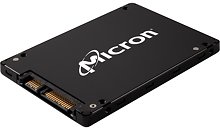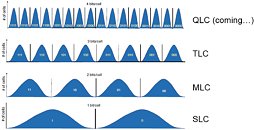Wednesday, February 14th 2018

Micron To Release QLC NAND-Based Drives in 2018 to the Server Environment
Micron has announced that they will be introducing QLC (Quad Level Cell) NAND-based, own brand drives for the server environment this year. The new QLC drives are expected to boost maximum storage density (and price per GB) closer to that of mechanical HDDs, which is why Micron is positioning drives based on this memory technology as data center-class SSDs for the nearline storage market. The company is positioning these drives as replacement options for 7,200 RPM HDDs for workloads that require heavy reads of stored information - thus offsetting QLC NAND's lower endurance when it comes to available maximum writes on the drives' cells.
It's a known trade-off when it comes to the NAND world: higher amounts of bits per cell to represent information means that there must be much increased accuracy when it comes to reading a given cell's voltage state. While SLC NAND only tracks two voltage states, MLC (2-bits per cell) tracks four voltage states, TLC doubles that to eight voltage states, and QLC doubles the ante again for a maximum 16 voltage states, where each voltage state represents data on the cell. Of course, with repeat writes and voltage changes, accuracy and capacity for the cell to maintain its given voltage tend to drop, which leads to incorrect information and thus corrupted data or those cells to be rendered inoperative. This is one of the reasons for manufacturers to include overprovisioning in their NAND-based solutions.That means these drives are much better suited for WORM workloads (Write Once, Read Many). The drive will be positioned below the existing 5200-series SSDs, and carry features aimed at hyperscale data centers.Perhaps Micron has developed a built-in resilience in its NAND chips to the deterioration that's expected from QLC drives, or maybe they've found a way to best or equal Toshiba, who announced last year that it had managed to increase endurance of its 3D QLC NAND flash to 1000 program/erase cycles by using a stronger ECC mechanism.The first batch of Micron-branded, QLC-based SSDs will have a SATA interface, though Micron said it is planning to release NVMe models. These will hit the enterprise markets first - where Micron has an easier task of recouping their investment due to higher revenue, while simultaneously allowing the company to take some more time to increase yields before adding the consumer demand strain to the equation. However, users should expect QLC-based drives to become real alternatives not too long after.
Sources:
AnandTech, PC Gamer
It's a known trade-off when it comes to the NAND world: higher amounts of bits per cell to represent information means that there must be much increased accuracy when it comes to reading a given cell's voltage state. While SLC NAND only tracks two voltage states, MLC (2-bits per cell) tracks four voltage states, TLC doubles that to eight voltage states, and QLC doubles the ante again for a maximum 16 voltage states, where each voltage state represents data on the cell. Of course, with repeat writes and voltage changes, accuracy and capacity for the cell to maintain its given voltage tend to drop, which leads to incorrect information and thus corrupted data or those cells to be rendered inoperative. This is one of the reasons for manufacturers to include overprovisioning in their NAND-based solutions.That means these drives are much better suited for WORM workloads (Write Once, Read Many). The drive will be positioned below the existing 5200-series SSDs, and carry features aimed at hyperscale data centers.Perhaps Micron has developed a built-in resilience in its NAND chips to the deterioration that's expected from QLC drives, or maybe they've found a way to best or equal Toshiba, who announced last year that it had managed to increase endurance of its 3D QLC NAND flash to 1000 program/erase cycles by using a stronger ECC mechanism.The first batch of Micron-branded, QLC-based SSDs will have a SATA interface, though Micron said it is planning to release NVMe models. These will hit the enterprise markets first - where Micron has an easier task of recouping their investment due to higher revenue, while simultaneously allowing the company to take some more time to increase yields before adding the consumer demand strain to the equation. However, users should expect QLC-based drives to become real alternatives not too long after.




6 Comments on Micron To Release QLC NAND-Based Drives in 2018 to the Server Environment
Of course, the actual reading is not visual, but the effect is virtually the same.
Considering some of the best TLC NAND have writes guaranteed in PB, they'll still exceed that, I have no idea why QLC should be scorned especially if they make SSD even cheaper?
SSDs have made us more aware of the fact that storage doesn't last forever. These days SSDs last longer than mechanical drives, but the psychological factor lingers on. Couple that with the general knowledge that making cells smaller reduces endurance and that reviews don't usually talk about endurance at all (in part because it's freaking hard to tell how many years a SSD will last) and the generic feeling of unknown when talking about a new product and you get an instinctive reluctance.
You may add to the list above the fact that manufacturers don't seem to forward about how they mitigate the electrical charge getting increasingly smaller.
I could add a few more things, but I think you get the gist already.